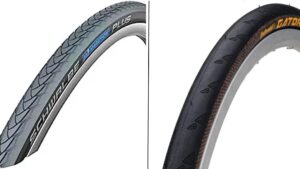Demystifying The World Of Carbon Fiber Wheels

Explore the advantages of carbon fiber bicycle wheels—enhanced performance, durability, and debunked myths. Demystify cycling's innovative technology today!
*This article may contain affiliate ads that help to support this site*
Bicycle wheels stand as the unsung heroes of cycling, wielding a profound impact on performance. Among the wheel materials, carbon fiber has emerged as a game-changer, altering the dynamics of cycling. The allure of carbon fiber lies in its remarkable properties—lightweight, robust, and performance-enhancing. This blog aims to demystify the realm of carbon fiber bicycle wheels, shedding light on their composition, benefits, and considerations for both enthusiasts and professionals. As cycling enthusiasts increasingly turn to carbon fiber for its promising advantages, understanding its nuances becomes paramount. Join us on a journey through the intricacies of these innovative wheels, unraveling the myths, and exploring their potential to revolutionize your cycling experience.
Understanding Carbon Fiber
Carbon fiber, a composite material known for its exceptional strength and lightweight nature, has revolutionized the cycling industry, particularly in the realm of bicycle wheels. Composed of thin strands of carbon—about 5-10 micrometers in diameter—woven together and bonded with resin, carbon fiber boasts an unparalleled strength-to-weight ratio.
The manufacturing process of carbon fiber wheels involves meticulous craftsmanship. It begins with laying the carbon fiber sheets in specific orientations to achieve desired strength and flexibility. These sheets are then infused with resin and cured to create a solid structure. The resulting wheel offers superior strength, capable of withstanding various forces encountered during cycling, while remaining remarkably lightweight.
The advantages of carbon fiber over traditional wheel materials, such as aluminum or steel, are manifold. Its exceptional stiffness provides better power transfer, allowing cyclists to convert more energy into forward motion. Furthermore, its lightweight nature significantly reduces rotational inertia, enhancing acceleration and maneuverability. This characteristic makes carbon fiber wheels highly desirable, particularly in competitive cycling where every fraction of a second counts.
Despite these benefits, carbon fiber is not without limitations. It can be more susceptible to damage from impacts compared to some metal alloys. However, advancements in manufacturing techniques and the incorporation of protective layers have substantially improved the durability of carbon fiber wheels, making them more resilient than ever before.
Benefits Of Carbon Fiber Wheels
The adoption of carbon fiber in bicycle wheels heralds a paradigm shift in cycling performance, offering an array of distinct advantages.
Enhanced Performance: Carbon fiber wheels fundamentally redefine a cyclist’s experience. The combination of exceptional stiffness and reduced weight amplifies performance, allowing riders to attain higher speeds with lesser effort. This enhanced performance is especially evident during accelerations and climbs, where the reduced rotational mass translates to increased agility and responsiveness.
Strength and Durability: While the perception of carbon fiber as fragile might persist, modern advancements in manufacturing have significantly enhanced its durability. Carbon fiber wheels, when well-constructed, exhibit exceptional resilience to various terrains and riding conditions. The material’s innate strength ensures a robust structure capable of withstanding rigorous riding without compromising performance.
Weight Reduction and Performance Impact: The reduction in weight is a hallmark feature of carbon fiber wheels. Lighter wheels contribute to reduced rotating mass, enabling quicker acceleration and easier maneuverability. This weight reduction extends beyond the wheels themselves, impacting the overall performance of the bike. The reduced weight in the wheels complements the bike’s overall agility and responsiveness, amplifying the cyclist’s experience.
The combination of these benefits leads to an overall improvement in a cyclist’s performance and experience. From professional racing to everyday cycling, the advantages of carbon fiber wheels manifest in increased speed, improved handling, and an overall more enjoyable ride. The innovative properties of carbon fiber significantly influence the trajectory of cycling, making it a pivotal choice for those seeking to elevate their performance on the road or the track.
Considerations For Choosing Carbon Fiber
Selecting the right carbon fiber wheels involves a careful evaluation of various factors to match individual cycling needs and preferences.
Types of Carbon Fiber Wheels: Understanding the different types of carbon fiber wheels available in the market is crucial. Choices include clincher, tubular, and tubeless wheels, each with its own advantages and considerations. Clincher wheels, for instance, are more convenient for tire changes, while tubular wheels offer a smoother ride due to their glued-on tires. Tubeless wheels provide puncture resistance and allow running lower tire pressures for enhanced comfort.
Factors to Consider: A crucial factor in choosing carbon fiber wheels is matching them to your riding style, body weight, and the terrain you typically ride on. Heavier riders may need sturdier wheels designed to bear more weight, while lighter riders might prioritize the weight of the wheels for increased performance. Similarly, the type of terrain—whether it’s mountainous, flat, or a mix of both—affects the choice of wheels in terms of their aerodynamics, stiffness, and durability.
Cost and Maintenance: The cost of carbon fiber wheels can vary significantly. Higher costs often correlate with lighter, more advanced designs. Consider your budget alongside the intended use of the wheels. Additionally, maintenance is a key consideration. Carbon fiber wheels might need specific care routines to ensure longevity and sustained performance, which might factor into your decision-making process.
By taking these factors into account, cyclists can make informed choices when selecting carbon fiber wheels, ensuring that the chosen wheels align with their riding style, body specifics, terrain preferences, and maintenance capabilities.

Hide A Bike Kit
Is your garage starting to become a mess? Save space by storing your bikes flat against the ceiling.
Common Myths and Misconceptions
Despite their growing popularity, carbon fiber bicycle wheels are often shrouded in myths and misconceptions, sometimes deterring potential users from reaping their benefits.
Myth of Fragility: A prevailing myth suggests that carbon fiber wheels are inherently fragile. While earlier iterations might have been more prone to damage from impacts, modern manufacturing techniques have significantly enhanced their durability. They’re designed to withstand rigorous riding conditions and can be as durable as, if not more durable than, traditional metal wheels.
Concerns About Safety: Another misconception revolves around safety concerns, particularly regarding catastrophic failure. While any material can fail under extreme stress, carbon fiber wheels are rigorously tested for safety and quality. When used within their specified parameters and maintained properly, they offer a safe and reliable riding experience.
Complex Repair Processes: Repairing damaged carbon fiber wheels might seem daunting, leading to the misconception that any damage is irreparable or costly to fix. In reality, specialized repair services exist to address minor damages, and many issues, such as small cracks or chips, can be effectively repaired, often at a fraction of the cost of a new wheel.
Hopefully, addressing these myths and misconceptions will help you make informed decisions about choosing carbon fiber wheels. Understanding the technological advancements and the true capabilities of these wheels can alleviate unnecessary apprehensions, allowing riders to confidently embrace the advantages of this innovative technology.

Hide-A-Bike Installation Guide
If you want to put together a Hide-A-Bike kit for yourself, just download these easy to follow, step-by-step directions, complete with a full hardware and parts list.
Conclusion
Carbon fiber bicycle wheels represent a transformative innovation in cycling technology. Their lightweight, robust nature, and performance-enhancing capabilities have redefined the standards of cycling. As misconceptions surrounding their fragility and safety diminish, the allure of carbon fiber wheels continues to grow. Understanding the nuanced selection criteria—considering riding style, terrain, and maintenance—empowers cyclists to make informed choices. Embracing the benefits of these wheels, from enhanced speed and agility to improved overall performance, promises an exhilarating riding experience. The future of cycling undoubtedly intertwines with the evolution and widespread adoption of carbon fiber, promising further advancements and continued excellence in the realm of wheel technology.
Share This Article With A Friend
Did You Read This Whole Article?

You deserve a gift! Enter your email to receive a FREE copy of the Hide-A-Bike Installation Guide! And once a month we will send you a newsletter with the best deals on the internet for bicycle gear and accessories.
About Hide A Bike

Save space by keeping your bike flat against the ceiling with the original easy and convenient bicycle storage solution.
Thank You For Visiting!

You deserve a gift! Enter your email to receive a FREE copy of the Hide-A-Bike Installation guide. And once a month we will send you a newsletter with links to our best finds on bicycle gear and accessories.
Share This Article:
Most Popular Articles:
Article Categories:
Related Articles:

How Wheel Shape Impacts Cycling Speed And Aerodynamics

How To Select The Best Wheels For Your Mountain Bike






